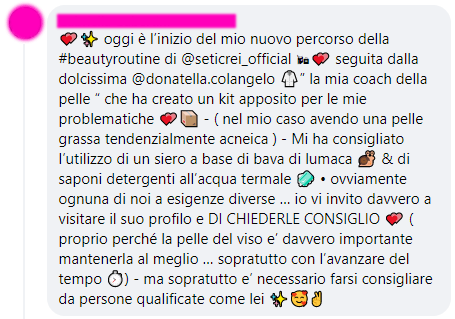Video: what is INCI?
When we use a cosmetic product, the softer the application, the more we like it and the more we convince ourselves that the product is doing us good. But is that really true? What is really in cosmetic products? Let's find out thanks to the INCI!
Published August 14, 2021 - Video Transcript.
Welcome back to Seticrei's youtube channel.
Today, as promised, I'm going to tell you about that indecipherable language named INCI.
First of all: what is INCI? It is the International Nomenclature of Cosmetic Ingredients: to put it very simply, it is nothing more than the recipe of a cosmetic product.
But before we start talking about INCI, I would like to focus on two very important aspects.
The first one is that everything - and I repeat everything - that we use at the epidermis level enters into circulation in our body, and to demonstrate this I will give you two examples: the patches that are used to treat muscle pain, the hormone patches... although they are applied on the epidermis their function reaches the inside of our body.
The second aspect - and I don't want to talk about the INCI - is that it is not just a recipe but a recipe for a cosmetic product.
The second aspect - not least - is the definition of a cosmetic product that is given by article 2 of the European Regulation 1223 of 2009 that came into force in July 2013, on which I want you to focus.
The article says that a cosmetic product means any substance or mixture of substances intended to be applied to the external surface of the body for the exclusive or predominant purpose of cleaning, perfuming, modifying appearance, protecting, maintaining health, or correcting body odors.
In the light of these two aspects, do you begin to understand what an extraordinarily important role it has for the consumer to read but above all to try to interpret the INCI?
Only from November 27th 1997 it has come into force the obligation for all the companies producing cosmetic products to indicate on the label in decreasing order of concentration the ingredients used for the formulation of the cosmetic product itself. Below one percent instead ingredients can still be listed in random order.
In spite of this there are still very few people who read the INCI, and very few who understand it.
Don't understand this and you risk using cosmetic products with substances to which you are allrgic or, as often happened to me, using cosmetic products preparatory to a problem and seeing my problem worsen, without giving me a real explanation.
This is why Seticrei decided to translate on the website in Italian all the INCI of the cosmetic products and to explain what each ingredient does at the epidermic level.
But we know very well that the choice of a cosmetic product is not always made after analyzing the INCI. On the contrary, very often we are captured by the claim of a product, that is by what it promises, by its fragrance - one of the major causes of energy -, by its texture, by who advertises it and only in the end, if a problem occurs or we have a particular problem, then the INCI comes into play.
In recent years, INCI is often under the magnifying glass. The main reason is surely the fact that, despite there are no scientific studies to support it, many of the substances used in the formulation of cosmetic products have triggered multiple reactions or epidermal problems.
I have been using INCI for many years, and I have been using it for many years.
Over the course of these twenty years I have compiled a list of ingredients that, based on my many years of experience, have given me, and many other people, a number of problems.
And what are these ingredients?
I'm talking about PARABENS, BHT/BHA, SILICONES/PARAFFINES/MINERAIL OIL/PEG, SLS/SLES...
Let's start analyzing one at a time, though: let's take it from parabens.
Do you know what parabens are? Parabens are preservatives that have been widely used in cosmetics for two reasons: first, because of their low cost and second, because they allowed cosmetics to be stored beyond 12 months.
And why is it that in recent years the absence of this substance, which should simply preserve, has become the workhorse of many cosmetic products?
The explanation is very simple: a study conducted by Dr. Dabre and a team of researchers from the University of Reading discovered the presence of parabens in the breast tissue of 18 out of 20 patients suffering from sense cancer. According to Dr. Dabre, the presence of parabens in breast cancer tissue is a fact not to be underestimated because it has been demonstrated how parabens can undermine the action of estrogens, hormones that if taken in large quantities could promote neoplastic processes.
Now you will see an image with the names that we find in the INCI to identify parabens.
BHT/BHA: what are they? They are synthetic preservatives used in cosmetics but also in food because of their low cost. Did you know that their use has been banned in some countries? According to some studies, in fact, these substances can cause irritation to eyes, skin, mucous membranes, and have been recognized as potential endocrine disruptors capable of interfering with our hormonal system, with the risk of altering its normal functioning.
Even think that BHA is on the AIRC list of substances recognized as possible carcinogens.
BHA and BHT are also believed to be toxic to the marine environment.
Now you'll see the BHA and BHT list.
Now you will see an image with the names we find in the INCI to identify BHA and BHT: SILICONES / PARAFFINS / MINERAIL OIL / PEG are chemically derived substances obtained from petroleum refining.
You heard me correctly: I actually mentioned petroleum. And what are petroleum-derived substances doing in a cosmetic product intended to improve the appearance of the skin? They are included in the vast majority of cosmetic products because we have always been accustomed to what is called "cosmetic pleasantness" and that is: when we use a cosmetic product, the softer its application, the more we like it and the more we are convinced that the product is doing us good.
The problem is that this pleasantness is simply tactile, due to these substances that form an absolutely transparent film that does not allow the epidermis to breathe, thus creating a series of problems such as under-the-skin dots, increased boils, itchy, dry feeling, red patches, increased oiliness.
Now you will see a picture with names we find in the INCI to identify silicones, paraffins, mineral oil and pegs.
SLS/SLES are anionic surfactants with a negative charge, widely used in facial and body cleansing products, as they are inexpensive and make a lot of foam, the kind we like: why can they be so harmful to our skin?
Their role should only be to dissolve dirt and make it slide off with water. When they are chemically derived, they are more aggressive and risk altering the physiological pH, the skin's only immune defense.
And just think that it takes 12 hours for our skin to return to its normal physiological pH, and we have probably already done a second cleansing before 12 hours.
So you see how our skin can be so harmful to us?
So you see how a simple cleansing, which is the most important gesture for all epidermal types, can prove to be compromising for the well-being of our health.
And how do we realize that we have altered the physiological PH? Because immediately after cleansing we feel it pulling, and I'm sure it will have happened to you many times.
I'm sure it will have happened to you many times.
Now you will see an image with the names we find in the INCI to identify SLS / SLES.
You may be thinking that I'm exaggerating, that there is nothing scientific to support what I'm saying, but believe me that every day in the personalized consultations I do, I meet people who complain of countless problems related to the use of simple cosmetic products.
Also because how many times in a day do we use cosmetics two, maybe three, and repeat this for months, years... do you really think it can never create any problems for us?
In light of everything I have told you, I have a question: do you believe that a cosmetic product that contains even just one of the ingredients I mentioned can meet the requirements of Article 2 to be defined as such?
I leave you with this question.
I leave this thought to you.
But the analysis of the INCI is not the only discriminating factor that must make us decide on the quality of a cosmetic product. To make me understand what I have just said, I will give you an example in the food sector. It has certainly happened to you to follow to the letter a recipe that a friend of yours has given you and to be disappointed with the result. And do you know why this happens? Because for the final result the list of ingredients is not enough, but the quality of the raw materials used comes into play.
The exact same thing happens in cosmetics: I am often asked why two cosmetic products with the same INCI have different prices.
There are two components that come into play: first of all the purity of the active ingredients contained in the cosmetic product, and then the percentage of the active ingredient contained.
Now you will see that the INCI of the cosmetic product is the same as the INCI.
Now you will see an exhaustive image of what I am telling you: as you can see, with the same INCI, changing the percentage of water, the product changes completely but to us, apparently, it looks the same.
Before I say goodbye, I'll leave you with this homework assignment: after listening to this episode, the advice is to analyze the INCI of the cosmetic products you are using, and you will see that a world will open up to you exactly as it did to me more than twenty years ago.
See you next time!
What they say about us



















